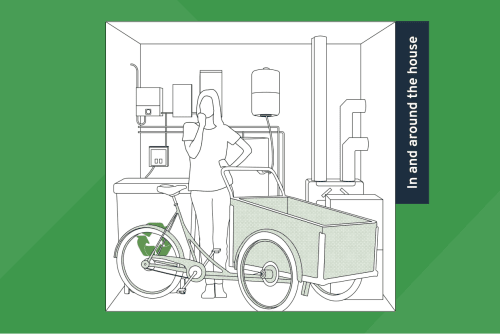I try to do my bit for the planet – cycling the toddlers to nursery – but there’s no suitable storage space. No use having a bike and recycling store if you have to take everything through the house.
The Future Homes Standard will be applied nationally through Approved Documents Part L (ADL) and Part F (ADF). It aims to ensure that homes will be ‘zero carbon ready’, becoming zero carbon homes over time as the electricity grid decarbonises, without the need for further costly retrofitting work. At the same time Local Authorities are able to set their own energy standards. Local Authorities have different versions of space standards and different interpretations of energy and carbon metrics, even before they have grappled with embodied energy and whole life carbon. Planning guidance proliferates, usually in the form of design, housing or sustainability Supplementary Planning Guidance. Bespoke solutions may be needed to meet the different objectives of local standards.
Well intentioned standards, for instance the now defunct Code for Sustainable Homes (CfSH), tried to embrace all aspects of sustainability but the outcome has not necessarily resulted in a better home for residents. Parts of the CfSH were so inflexible and prescriptive that the standard became the design – large bike stores occupying most of the outdoor space, overshadowing main rooms and dominating outlook, at the expense of garden area. Whereas ‘market’ solutions were available that were more secure, more functional and more compact.
In contrast to these prescriptive requirements the complexity in other parts of CfSH required designers to consult different, and sometimes contradictory, external standards and guidance. This complexity is already apparent in the 2021 Approved Documents where readers are advised to be aware of the ‘interaction’ of different parts. A designer needs to understand the interaction between ADF (Ventilation) and ADL (Conservation of fuel and power). Approved Document Part O must be tackled before energy assessments for ADL are underway and, as it will influence the number, position and size of windows, should be consulted before planning submissions are made.
A simple fact of providing space for recycling, for bicycles, for flexibility and adaptability, for equipment and energy storage is that more storage space needs to be allocated in the future home, without compromising living space. It is a strange paradox of the modern technological age, where miniaturisation is key, that homes are likely to need more space for non-living areas than ever before (see NHBC NF80 Futurology: the new home in 2050).
Things that can go wrong:
- competing standards compromising quality objectives
- designing down’ to the standard
- inconsistent interpretation and application of standards across jurisdictions.
Future-proofing recommendations:
- DESIGN: Allow more space for cavity walls, water cylinders, radiators and storage;
- DESIGN: Prioritise homeowners and ensure homes are practical, flexible and functional;
- DESIGN: Think beyond standards and ‘compliance’ for better outcomes.
Further Reading
Gov.uk, Statutory guidance: Technical housing standards – nationally described space standard
The minimum standard of built-in storage in new homes does not accommodate many energy saving items. However planning authorities in England can set their own energy targets and space standards. (Gov.uk, Statutory guidance: Technical housing standards – nationally described space standard, 27 March 2015, p5)
Energy use in the residential sector is responsible for 22% of the UK’s carbon emissions. (Gov.uk Department for Business, Energy & Industrial Strategy, 2019 UK Greenhouse Gas Emissions, Final Figures, 2 February 2021, p13)
Report Chapters
Explore NHBC Foundation

About NHBC Foundation research
Delivering high-quality research and guidance to help the house-building industry address the challenges of delivering 21st-century new homes.

Access NHBC Foundation publications
Access and download NHBC Foundation’s full portfolio of publications and practical guides, covering primary research, research reviews and documents informing the debate.

Latest NHBC Foundation news
View the latest NHBC Foundation news, articles and facts showcasing the most recent publications and reporting on progress with new research projects.
Technical disclaimer
The information provided or contained on this website has been produced by NHBC for research and guidance purposes through the “NHBC Foundation”. It has not been created or intended for distribution or use outside of the purpose for which it was drafted. The information contained on this website does not constitute advice and is not to be relied upon by any third party. Any third party who chooses to rely upon the information contained on this website shall do so entirely at their own risk and NHBC accepts no duty of care or liability, however caused, in connection with its use or reliance by any third party. It is not updated or maintained.
This website may contain links to websites operated by third parties. Third party websites are not under our control, and we are not responsible for the content of any third-party website, or any link contained in a third-party website. NHBC do not review, approve, monitor, endorse, warrant, or make any representations with respect to third party websites. Any third party who chooses to rely upon the information contained on a third-party website shall do so entirely at their own risk. NHBC accepts no duty of care or liability, however caused, in connection with its use or reliance by any third party.
